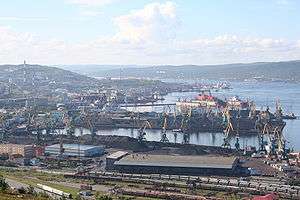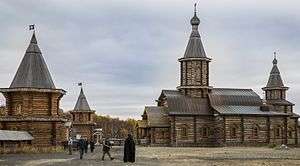Murmansk Oblast
Murmansk Oblast is the northernmost region of Northwestern Russia, on the Kola Peninsula, which borders Finland's Lapland to the west, Norway's Finnmark Region to the northwest, the Barents Sea to the north, the White Sea to the southeast, and Karelia to the south.
Understand

Murmansk is the only major city on the Kola Peninsula; it is Russia's main merchant and fishing port on the Arctic Ocean.
The region's smaller cities mostly owe their existence to mining and mineral processing: Monchegorsk was founded at a copper and nickel mine (which is now exhausted, but the associated metal refinery keeps operating, using ore from Norilsk), Olenegorsk and Kovdor mine iron ore, Kandalaksha has an aluminum refinery. It is not too hard to guess that Apatity processes apatite (the source material for phosphorous fertilizer, mined in nearby Kirovsk), while Nikel (and nearby Zapolyarny) mine and process nickel ore.
A special permit may be required for visiting the naval harbors (Severomorsk, Polyarny, etc.) and air bases in Kola Fjord north of Murmansk, or elsewhere in the region.
Besides Russians, the peninsula also has an indigenous population of Sami people. Many of them live in the Oblast's Lovozero District, and are engaged in reindeer husbandry.
Murmansk Oblast is of interest to a tourist mostly for its novelty value—it is in Russia's extreme north, above the Arctic Circle, and is relatively easy to get to from Saint Petersburg. The highlights of a Murmansk Oblast trip are its capital and perhaps also an adventurous trip out to Kola. To heighten the novelty value of your trip, try to come around the summer Equinox, when the sun moves around the sky but never sets, or the winter Solstice, when the sun never rises and the region is plunged into blackness. The winter is cold, but it is also the best time to see the Northern Lights.
Each year, Murmansk Oblast plays host to the Festival of the North, known as Pradznik Severa, a 10-day annual sporting event in 20 winter sports.
Cities

- 🌍 Murmansk — the capital and largest city is an important naval base and has a large sea port which remains ice-free year round; the world's largest city north of the Arctic Circle
- 🌍 Kandalaksha
- 🌍 Kirovsk — a large town with the world's northernmost botanical gardens and a ski resort in the Khibiny Mountains
- 🌍 Kola — the peninsula's oldest town boasts its original fort, the Cathedral of the Assumption (the first stone building in the region), and a museum of local culture
- 🌍 Polyarny — a closed town, one of the region's oldest, on the Murmansk Fjord; it is now a site for decommissioning nuclear Soviet and Russian submarines
- 🌍 Severomorsk — a closed city, the region's second largest city, and the main administrative center of the Russian Northern Fleet
Other destinations

Talk
See Russian phrasebook and Sami phrasebook.
Get in
By plane

The easiest way to get in is via Murmansk's airport (MMK IATA), which is served by flights from Moscow, Saint Petersburg, and Arkhangelsk. There are also flights from northern Norway and, seasonally, from Helsinki in Finland.
A smaller airport operates in Apatity/Kirovsk, with flights from Moscow, St Petersburg, and a few other destinations.
By train
A single railway, constructed during World War I, connects Murmansk with the rest of Russia. On the way to Murmansk, trains stop in most other cities of the province (Kandalaksha, Polyarnye Zori, Apatity, Olenegorsk [for Monchegorsk]), Kola).
Several trains a day run to Murmansk from Moscow (at least 28 hours) and St Petersburg (24 hours); on the way to Murmansk, they also stop in Petrozavodsk and other towns of Russian Karelia.
There is also a train to Murmansk from Vologda. During the summer holiday season, additional trains are scheduled between Murmansk and popular resort destinations in southern Russia.
Overland from Finland or Norway
From Finland, take the overnight train departing about 19:00 from Helsinki to Rovaniemi. Continue from Rovaniemi by bus in the morning, transfer in Ivalo in the early afternoon (Monday, Wednesday and Friday) and be in Murmansk 22:50, spending about the same time on the journey as from Saint Petersburg (including some hours in Rovaniemi and Ivalo). There is probably also a bus from Rovaniemi via Kemijärvi and Salla to Kandalaksha.
There are roads with border crossings, from Kirkenes in Norway, and Ivalo in Finland.
Get around
Most of the region's population centers are located in the north-south valley between Kandalaksha and Murmansk, along which both by the St Petersburg-Murmansk railway (with several trains a day) and St Petersburg-Murmansk highway (with several buses a day) run. Buses on the highway run via Kandalaksha, Monchegorsk, and Olenegorsk, with Apatity and Kirovsk on a branch road. Trains run east of Lake Imandra, between Kandalaksha, Apatity, Olenegorsk, and Murmansk.
The highway and railway from Murmansk toward the northwestern Pechenga District and the Norwegian border have much less frequent service.